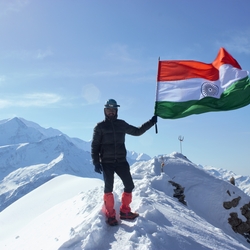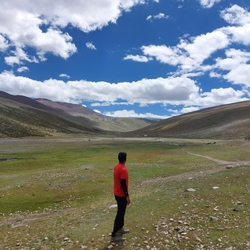High altitude treks inevitably mean spending multiple nights in tents higher up in the mountains. Camping at higher altitudes is different from what one would experience on shorter treks in lower altitudes. As we move higher up, there is a significant change in the terrain, atmosphere and climatic conditions which make camping more challenging. It always helps to be aware of such challenges and prepare beforehand to ensure a smooth trekking experience. Some of these challenges could even help you decide if you want to opt for a high altitude trek.
Following are a few common challenges that could possibly arise while camping in higher altitudes in the mountains along with how it could be different from low altitude treks.

Living Conditions
Inside the tent
Needless to say, the living conditions at higher altitudes are testing. With lower oxygen levels and severe temperature drops, getting a good night’s sleep could prove to be difficult if you are not well prepared. The comfort of a room with a snug blanket is far from reach and your sleeping bag is your best friend. It is important to keep yourself warm and use your camping equipment to their full potential. Always make sure you use a foam mat in your tent to keep your sleeping bag warm and have a smooth surface to sleep on.
Outside the tent
It could also be difficult to spend time outside your tent if you are not insulated properly. Ensure that you have all your layers on, particularly your socks and gloves. Walking around the campsite without any insulation for your feet and hands could result in frostbite.
Toilet tents
It is common trekking practice to pitch toilet tents with pits dug out for everyone’s use. It is important for you to be comfortable with such practices as there are no modern toilets that will be available. It also serves well to know that using water in the toilet tents is restricted; you will need to carry your own toilet paper. On the more difficult expeditions, toilet tents are not carried to the higher camps (above base camp) due to restriction of space (to pitch the tent).
Lighting
Campsites are devoid of artificial lighting, meaning you will have to entirely rely on a torch or headlamp to move around and perform tasks at night. Ensure that you have a personal torch or headlamp which is fully charged and will last for the entire duration of the trek. Carry multiple or extra batteries if needed.
Food
On treks to higher altitudes, food and ration is carried from the base camp to last for the duration of the trek. The food served is often simple but energy giving. You need to keep in mind that a wide variety of food options will not be available to you given the laborious process of carrying raw materials and also preparing the dish in harsh climatic conditions. This is in contrast to smaller treks where you might encounter local eateries and homestays on some of the routes or on others have an army of support staff in tow who cook fresh meals three times a day.
Mountaineering expeditions are in complete contrast to the above. Climbers carry ready to cook packets which are boiled in hot water and consumed as is. It could take some time to get accustomed to eating food this way. While this might be new and difficult to adapt to, it is important to not skip meals during the expedition. Remember that food and water play a huge role in facilitating acclimatisation and avoiding altitude related illnesses. The dry air and air pressure change also reduce the sensitivity of our taste buds, which means food might not taste all that great. It would be good to carry oat and granola bars which are mixed with dry fruits and berries. These are packed with protein and carbohydrates and the gooey texture of the berries and dry fruits keep them from becoming hard and inedible.
Water
Water during a trek is procured from water sources available to us on the route. It would be a herculean task to carry water for everyone along with food and ration. Streams and freshwater lakes are our primary sources of water on treks. With the gradual decline of the treeline, there is also a decline in accessible water sources. Always refill your water bottles when you have the opportunity and keep yourself hydrated. If you are someone who falls ill quickly due to changes in water, carry filter tubes or water purification tablets. These could be handy even if you are accustomed to drinking water from streams. Be extremely mindful of how you use water for washing your dishes or clothing items. On expeditions, snow is collected and melted on butane as a source of water. Under such conditions, it becomes essential to use the available water economically since firstly, we have limited butane and secondly, it takes a long time to melt small quantities of water from snow; it is a lengthy process. However, do not compromise on keeping yourself hydrated at all times. An appropriate amount of water intake is vital for acclimatisation. The frugal use of water should be restricted to other avoidable activities such as washing yourself or using water to clean your vessels wherever it’s not necessary.
Weather
High altitude treks are almost synonymous with extreme climatic conditions and weather changes. As you move higher up, you will experience severe temperature drops, harsh UV rays from the sun, snow or even unexpected rainfall. The mountain makes its own weather and it is important to be prepared to tackle such weather changes. Night temperature could drop below 0℃ accompanied by snowfall and winds. Carry extra layers of clothing and insulate yourself to keep warm and comfortable at all times. Windcheaters and rain jackets could prove to be useful on most high altitude treks. While weather changes and low temperatures are also common on smaller treks, the changes are more extreme and harsh higher up, particularly on expeditions. Tents and sleeping bags carried on expeditions are made from materials that offer higher insulation to protect from the bitter cold due to snow and strong winds. They are also shaped differently to hold against the winds in higher altitudes and accommodate more people.
Camping Sites
A number of factors go into picking the right campsite during a trek or expedition. On smaller treks at lower altitudes, this is relatively easier given the presence of the treeline and abundant water streams. Choosing campsites at higher altitudes on expeditions requires a lot more planning and a thorough understanding of the surrounding terrain. While it is common practice to camp close to a source of water, the possibility of rockfall or an avalanche must also be kept in mind. Given that the treeline significantly declines and the terrain is more dry with loose rocks and moraine, the choice of campsite could make or break the expedition. Furthermore, on expeditions, space is a constraint, thus making climbers huddle together in tents. The terrain below may not always be flat, making it difficult to have a comfortable nap at night.
Geographical Features
High altitudes also bring a range of different and challenging geographical features to the table. Traversing and navigating around these features and terrains requires exceptional skill and technical knowledge. Climbers cannot pitch a tent for the day as they deem convenient as a lot of these geographical features are layered and might not be visible at first glance. Crevasses that run as deep as 150 ft. are sometimes covered with a layered snow strong enough to stand on but might collapse beneath you over the weight of your tent and other equipment. Similarly, climbers with sufficient experience can also gauge whether a particular spot may be more susceptible to rockfall or avalanche. It is extremely important to understand these terrains and features along with knowing how to move around them before setting out to camp on an expedition. (Read: Geographical Features and Kinds of Terrain Encountered on Mountaineering Expeditions)
While nothing can stop unexpected circumstances during high altitude treks, it helps to always be prepared to encounter the above challenges in the best way possible. It is important to take time and prepare yourself both physically and mentally along with ensuring that you have everything you will need for the duration of the expedition. This will help you have a comfortable and smooth outdoor experience. Should you have any questions about camping in high altitudes, our team is available to answer and resolve your queries.






